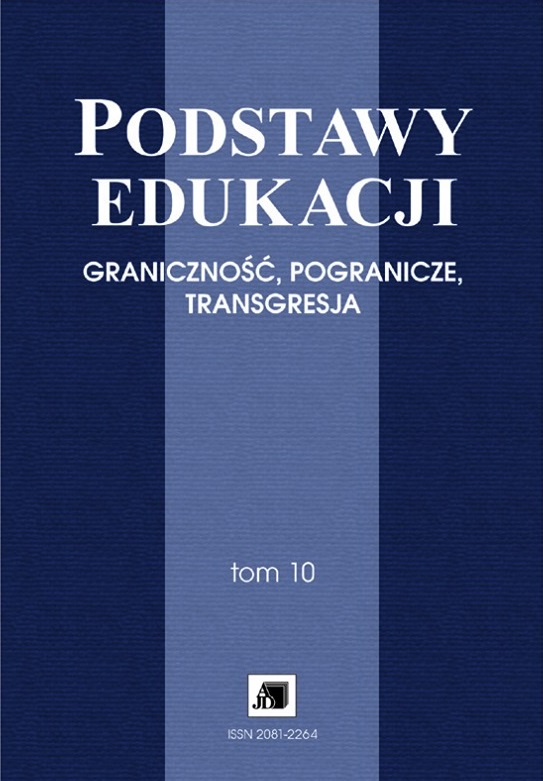Abstrakt
Niniejszy artykuł analizuje zagadnienie tulku, czyli ludzi uważanych za reinkarnacje tybetańskich mistrzów. Pokazuje znaczenie tulku w buddyzmie tybetańskim i charakter tradycyjnej edukacji mnichów (wszyscy tulku muszą być mnichami w czasie nauki w szkole). Przedmiotem zainteresowania autora jest krytyka systemu edukacyjnego tulku, zarówno w Tybecie, jak i poza nim. Tekst pokazuje, że to, co było przedmiotem krytyki ze strony innych autorów opisujących feudalny Tybet (korupcja, przemoc wobec młodego tulku), nadal stanowi problem w klasztorach buddyjskich poza Tybetem. Kilku młodych tulku zrzuciło szaty mnisie, a część z nich porzuciła buddyzm.
Bibliografia
A new dawn of tulkus (2012). http://www.dorjeshugden.com/forum/index.php? topic=2389.5;wap2 [dostęp: 29.04.2016].
A Day in the Life of a Monk (b.d.). http://tibetansponsorship.org/sera-jeymonastry/a-day-in-the-life-of-a-monk [dostęp: 17.05.2017].
Ary, E. (2013). The Westernization of Tulkus. W: V.R. Sasson (red.), Little Buddhas: Children and Childhoods in Buddhist Texts and Traditions. Oxford: Oxford University Press, 398–427.
Barlocher, D. (1982). Testimonies of Tibetan Tulkus: A Research among Reincarnate Buddhist Masters in Exile, 1, Rikon/Zurich.
Bishop, P. (1989). The Myth of Shangri-La: Tibet, Travel Writing and the Western Creation of Sacred Landscape. London: Athlone Press.
Bloch, N. (2011). Urodzeni uchodźcy: Tożsamość pokolenia młodych Tybetańczyków w Indiach. Wrocław: Wydawnictwo Uniwersytetu Wrocławskiego.
Butrymowicz, S. (b.d.). A day in the life of Chinese students. http://hechingered.org/content/a-day-in-the-life-of-chinese-students_3826 [dostęp: 21.08.2017].
Campbell, J. (1996). Traveller in Space: In Search of Female Identity in Tibetan Buddhism. New York: George Braziller.
Chögyam Trungpa (1983). First Thought Best Thought: 108 Poems. Boulder: Shambala.
Chögyam Trungpa (2003). Journey Without Goal. W: tegoż, Collected Works. 4. Boston: Shambala, 1–135.
Chögyam Trungpa Rinpocze (2016). Urodzony w Tybecie. Poznań: Dom Wydawniczy Rebis.
Choseng Trungpa (b.d.). https://en.wikipedia.org/wiki/Choseng_Trungpa [dostęp: 18.06.2016].
Chua, A. (2011). Bojowa pieśń tygrysicy. Prószyński i S-ka: Warszawa.
Dalajlama (1993). Wolność na wygnaniu: Autobiografia jego świątobliwości Dalajlamy Tybetu. Warszawa: Wydawnictwo Atlantis.
Datta, K. (2000). Reincarnation and Politics in Tibet. Bulletin of Tibetology, New Series. 1–3, 1–13.
Dreyfus, G.B.J. (2003). The Sound of Two Hands Clapping: The Education of a Tibetan Buddhist Monk. Berkeley: University of California Press [epub].
Dzongsar Jamyang Khyentse Rinpoche (2016). Time for Radical Change in How We Raise Our Tulkus. Tricycle. 22.08.2016, https://tricycle.org/ trikedaily/time-for-radical-change-in-how-we-raise-our-tulkus [dostęp: 30.04. 2017].
Etesami, R. (b.d.). Tulku System in Tibetan Buddhism: Its Reliability, Orthodoxy and Social Impacts. M.A. Thesis, International Buddhist College, Thailand.
Falk, G.D. (2009). Stripping the Gurus: Sex, Violence, Abuse, and Enlightenment. Toronto: Million Monkeys Press.
Gyatso, J. (1998). Apparitions of the Self: The Secret Autobiographies of a Tibetan Visionary. Princeton: Princeton University Press.
Hooper, J. (2012). Blowing the Whistel on Sexual Abuse at Buddhist Monasteries. Des Tibetischen Buddhismus. http://www.lamatruth.com/ying/?type =detail&id=225 [dostęp: 20.02.2017].
Kapstein, M.T. (2010). Tybetańczycy. Kraków: Wydawnictwo Uniwersytetu Jagiellońskiego.
Kawaguchi, E. (1909). Three Years in Tibet. Adyar: Vedanta Press.
Laird, T. (2008). Opowieść o Tybecie: Rozmowy z Dalajlamą. Poznań: Dom Wydawniczy Rebis.
Landon, P. (1905). Lhasa: An account of the country and people of Central Tibet and of the Progress of the mission sent there by the English Government in the year 1903–4. London: Hurst and Blackett.
Mackenzie, V. (1989). Reincarnation: The Boy Lama. London: Bloomsbury Publications.
Mackenzie, V. (1995). Reborn in the West: The Reincarnation Masters. London: Bloomsbury Publications.
Maraini, F. (1993). Secret Tibet. Delhi: Book Faith India.
Martin, M. (2003). Music in the Sky: The Life, Art, and Teachings of the 17th Gyalwa Karmapa Ogyen Trinley Dorje. Ithaca: Snow Lion Publications.
Mukpo, D.J. (2008). Dragon Thunder: My Life with Chögyam Trungpa. Boston: Shambala.
Mullin, G. (2008). Czternastu Dalajlamów: Spadkobiercy oświeconej mądrości. Warszawa: Agencja Wydawnicza Jacek Santorski & Co.
Namkhai Norbu (1991). Istota dzogczen. W: tegoż, Rób to na co masz ochotę. Kraków: Wydawnictwo Miniatura, 27–43.
Namkhai Norbu (2001). Kryształ i ścieżka światła: Sutra, tantra i dzogczen. Kraków: Wydawnictwo „A”.
Ngałang Zangpo (H.L. Thompson) (2002). Rozpoznawanie inkarnowanych mistrzów. W: Dziamgon Kongtrul Lodro Thaje. Intronizacja: Odnajdywanie inkarnowanych mistrzów Tybetu i Himalajów. Kraków: Wydawnictwo Mudra, 67–71.
Osel Hita Torres – The Reluctant Lama (2012). BBC News, 28.09.2012. http://www.bbc.com/news/magazine-19702122 [dostęp: 29.04.2016].
Pallis, M. (1946). Peaks and Lamas. London: Cassell and Company.
Ravidas, R., Mangar, N. (2016). Renunciation on FB – Not a monk any more, says post. The Telegraph. August 12. https://www.telegraphindia.com/ 1160812/jsp/frontpage/story_102067.jsp [dostęp: 26.06.2017].
Ray, R. (1986). Some Aspects of the Tulku Tradition in Tibet. Tibet Journal, 11:4, 35–69.
Sieradzan, J. (2007). Koncepcja umysłu w buddyzmie. Idea: Studia nad Strukturą i Rozwojem Pojęć Filozoficznych, 19, 13–32.
Sieradzan, J. (2005). Szaleństwo w religiach świata: Szamanizm, religia starogrecka, judaizm, chrześcijaństwo, hinduizm, buddyzm, islam. Kraków: Inter Esse, Wydawnictwo Wanda.
Sieradzan, J. (2018). Zmotoryzowani tulku: Zachodnie reinkarnacje tybetańskich buddystów. Warszawa: Wydawnictwo Psychologii i Kultury Eneteia.
Tenzin Gyatso, 14th Dalai Lama of Tibet (2011). Reincarnation. http://www. dalailama.com/messages/statement-of-his-holiness-the-fourteenth-dalailama-tenzin-gyatso-on-the-issue-of-his-reincarnation [dostęp: 22.05.2016].
Thondup, T. (2011). Incarnation: The History and Mysticism of the Tulku Tradition of Tibet. Boston: Shambala [epub].
Thondup Rinpocze, T. (1998). Ukryte nauki Tybetu: Wyjaśnienie dotyczące tradycji term w buddyjskiej szkole Ningma. Warszawa: Wydawnictwo Mandala.
Tworkhov, H. (1996). The Emperor’s Tantric Robes: An Interview with June Campbell on Codes of Secrecy and Silence. Tricycle. Winter. http://www. anandainfo.com/tantric_robes.html [dostęp: 11.06.2016].
Wilde-Blavatsky, A. (2013). What Lies Beneath the Robes: Are Buddhist Monasteries Suitable Places for Children? Elephant Journal, 7.06.2013, http://www.elephantjournal.com/2013/06/what-lies-beneath-the-robes-are-buddhist-monasteries-suitable-places-for-children-adele-wilde-blavatsky [dostęp: 11.06.2016].
Filmografia
My Reincarnation (2011). Reżyseria Jennifer Fox.
Tulku (2009). Reżyseria Gesar Mukpo, Kanada.
Mam świadomość, że czasopismo jest wydawane na licencji Creative Commons - Uznanie autorstwa (https://creativecommons.org/licenses/by/4.0/legalcode).
Przesyłając artykuł wyrażam zgodę na jego udostępnienie na tej licencji.
